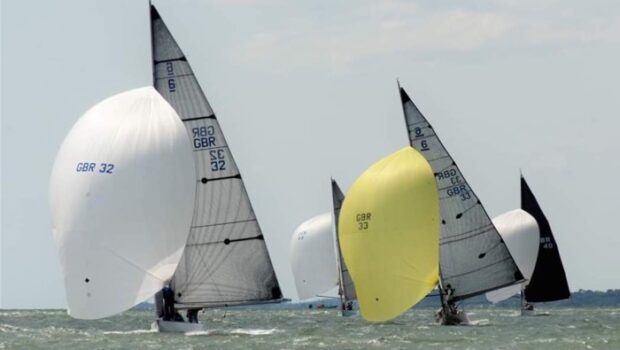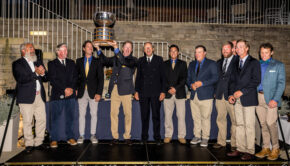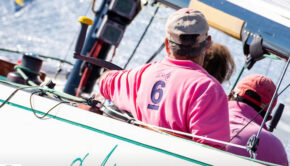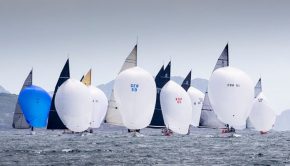Six Metre Worlds coming to Cowes
Published on August 29th, 2023
Preparations in Cowes are in full swing to welcome 34 teams representing 11 Nations from across Europe and North America for the 2023 International Six Metre World Championship, to be hosted by the Royal Yacht Squadron from August 29 – September 8. The fleet is divided into two divisions, the Open Division and the Classic Division for those yachts built prior to December 31, 1965.
Amongst those competing will be the defending Open and Classic Division Champions, Momo and Dix Août. In the Open Division Dieter Schoen’s Momo, a Judel/Vrolijk design launched in 2022, will be aiming for a second consecutive win. But she will have tough competition from the likes of Jan Eckert’s Gingko Too, a 2020 Javier Cela design; Violeta Alvarez’ 2017 Juan Kouyoumdjian designed Stella; and new kid on the block Oiva, designed by Allan Savolainen, launched in 2022 and owned by Finland’s Henrik Andersin.
An interesting new addition to the Open Division is Aera, the 1988 Pelle Petterson design formerly known as Rebecca, which has been purchased by Nicholas and Fotis Lykiardopulo and undergone considerable work to prepare her for the event.
The Open Division may be nicknamed the “Moderns”, but even here the boats will span some forty years. Built in 1981 the Petterson/Howlett designed Junior may be the oldest boat in the Open Division but she’s arguably the most successful post-1965 boat having won the Worlds in 1999, 2007, 2011, 2015, 2017 and 2019 and the Europeans in 1996, 1998, 2000 and 2002.
Launched just last October and racing in her first ever world championship is Henrik Andersin’s Oiva. Henrik is a long standing Six Metre owner having previously owned both classic and modern sixes. There has been a significant resurgence of interest in the Six Metre Class in recent years, with a number of new boats being launched. Construction of Oiva at Red Sky Yachts at Kotka in Finland has been documented on the International Six Metre Archive and can be seen here.
In the classic division Dix Août, a 1950 Bjarne Aas design owned by Louis Heckly, will defend her title, but this time with the legendary French offshore and Dragon sailor Géry Trenteseaux at the helm. Meanwhile Louis, who is also the President of the International Six Metre Class, will be racing the stunningly beautiful 1937 Olin Stephens designed Fun. The two boats have been training hard all season and will both be hoping to put in a good showing.
The Sanxenxo based Bribon is a two time past Classic World Championship winner and came second last year so will be hoping for a return to the top step of the podium this year. From Port Madison YC, USA, comes Peter Hofmann and Rainer Mueller’s 1948 Olin Stephens designed Llanoria, which competed in two Olympic Games, winning Gold on both occasions, and also the winning classic in the 2015 World Championships. Always a very fast boat she will definitely be one to watch this time around.
The oldest boat racing in the Classic Division will be the 1927 Johan Anker designed Sioma owned by Fenton Burgin, closely followed by Tom Owen and Dirk Stolp’s 1930 Alfred Mylne designed Valdai and Simon J. William’s 1931 Anker & Jensen designed Abu. The youngest Classic racing will be Thomas Kuhmann’s 1955 Hanko III designed by Bjarne Aas, although Nirvana, which is a reconstruction of a 1939 Olin Stephens design, is technically the most recently built of the Classics at this event.
Boats have been arriving in Cowes over recent weeks to train on the Solent, and registration for the regatta will begin on August 29. The official practice races will be held from on September 1-2. On September 3 the class will hold its AGM and a Race Officer’s briefing, after which competitors will be invited to enjoy a Regatta Opening Reception at the Royal Yacht Squadron.
World Championship racing will commence on September 4 with up to eight races scheduled between then and the regatta’s conclusion on September 8.
Event Details – Entries – Facebook
About The International Six Metre Association
The International Six Metre Class has managed to retain the heritage of international class racing in thoroughbred boats that don’t have to break the bank. We believe some 1225 Six Metre boats exist around the world today. Early Fife boats built in 1907 are still racing – often against new Moderns. Some classics have been beautifully modified for cruising; several race only occasionally.
The class has managed to cover a wide range of sailing need. All have one thing in common: their distinctive sailing silhouette and an adherence to a tried and tested formula. They are a tribute to their designers and builders, and there is no doubt the class generates a passion and devotion driven by the stunning appearance of the boats and their historical significance.
Now more than a century since the first rule was written, metre boats remain at the forefront of yacht development – they were among the first boats sailing in the Olympics, right from the 1908 London Olympics until the 5.5 Metres in 1968 in Mexico, and Six Metres were regularly used for the British-American Cup (team racing and an event far more prestigious than the America’s Cup in its day). The Six Metres have also been used for the legendary Seawanhaka Cup (match racing) no less than 16 times from 1927 through to 1987, by far the largest number of appearances by a class in the event.
Hull designs have always been technologically advanced. Wing keels, rod shrouds and the latest in sail composition on the Moderns contrast with the ageless wooden decks and fittings of the Classics. In recent years there has been a real resurgence of interest with many old boats being restored, new boats being built and some of the mega-stars of the sailing world choosing metre boats for their personal sailing. The International Six Metre Association has members in most European and American sailing centers.
Source: Fiona Brown









 We’ll keep your information safe.
We’ll keep your information safe.